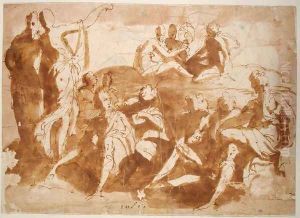Bernadino India Paintings
Bernardino India, an Italian painter of the Renaissance period, was born in 1528 in Verona, Italy. He was an influential artist in the Veronese school of painting, which was characterized by the use of vivid colors and a preference for dramatic compositions and was also influenced by the Mannerist style. India's work showed a clear influence from his contemporaries, including Paolo Veronese and Parmigianino, and he is noted for his frescoes and oil paintings.
Bernardino India was trained by his father, who was also a painter. He later became a student of Francesco Torbido, also known as Il Moro. Through Torbido, India was exposed to the works of Giulio Romano, which had a lasting impact on his artistic development. India's early works were frescoes in local churches, such as the Church of San Bernardino in Verona. He also worked on commissions for various local nobles and religious institutions.
Throughout his career, Bernardino India painted a variety of subjects, including religious scenes, mythological themes, and portraits. His style evolved over time, showcasing his ability to adapt to the changing tastes and artistic trends of his era. India's paintings were known for their elegant figures and the emotional intensity of the scenes depicted.
Despite his accomplishments, Bernardino India did not achieve the same level of fame as some of his contemporaries. Nevertheless, his work has been recognized for its quality and contribution to the Italian Renaissance. India's frescoes and other paintings can still be seen in Verona and other parts of Italy.
India died in 1590 in Verona. His legacy endured through his contributions to the art of the Veronese school and the students he taught, who carried on his techniques and stylistic approaches. Although not as widely known as other Renaissance artists, India's work remains an important part of the history of Italian Renaissance art.
